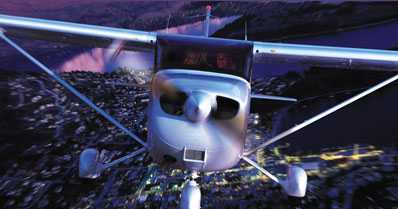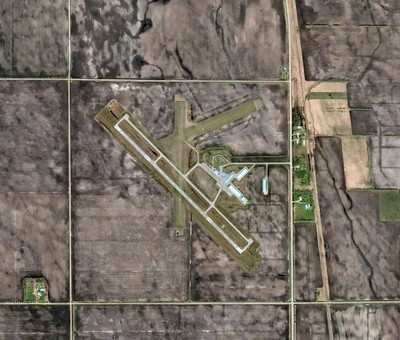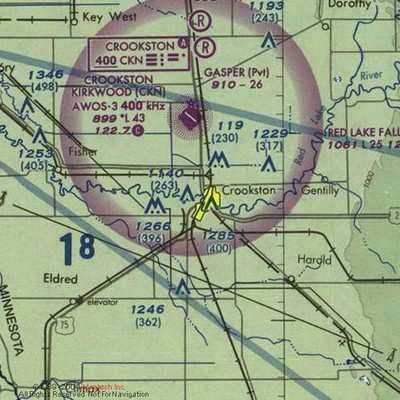 The NTSB has updated
its investigation of a fatal 2006 Cessna crash that took the lives
of 2 University of North Dakota students. The factual report, a
prelude to the ultimate finding of a probable cause notes that IFR
conditions appear to have been a significant factor in the accident
that took the lives of pilot Jacob Rueth (18), and passenger Jacob
Sundblad (19). Despite launching into IMC that had deteriorated to
a mile visibility, the pilot had yet to log any actual flight time
in IFR conditions. No mechanical problems have been mentioned as a
potential cause of the accident.
The NTSB has updated
its investigation of a fatal 2006 Cessna crash that took the lives
of 2 University of North Dakota students. The factual report, a
prelude to the ultimate finding of a probable cause notes that IFR
conditions appear to have been a significant factor in the accident
that took the lives of pilot Jacob Rueth (18), and passenger Jacob
Sundblad (19). Despite launching into IMC that had deteriorated to
a mile visibility, the pilot had yet to log any actual flight time
in IFR conditions. No mechanical problems have been mentioned as a
potential cause of the accident.
NTSB Identification: CHI07FA032.
The docket is stored in the Docket Management System (DMS). Please
contact Records Management Division
14 CFR Part 91: General Aviation
Accident occurred Friday, December 01, 2006 in Crookston, MN
Aircraft: Cessna 172L, registration: N9850G
Injuries: 2 Fatal.
History Of Flight
On December 1, 2006, about 1830 central standard time, a Cessna
172L, N9850G, piloted by a private pilot, was destroyed when it
impacted terrain near Crookston, Minnesota. The 14 CFR Part 91
personal flight was operating in instrument meteorological
conditions without a flight plan. The local flight originated from
the Crookston Municipal Airport-Kirkwood Field (CKN), about
1815.
A witness reported seeing two people removing the accident
airplane from a hangar at 1800. He stated that he saw the accident
airplane outside of the hangar and that the two people were pushing
another airplane back into the hangar. He reported that he did not
see the people board the airplane, nor did he see the airplane take
off.
At 1850, an emergency locator transmitter signal was detected by
the Air Force Rescue and Coordination Center. The Civil Air Patrol,
local authorities, and the CKN airport manager were contacted
regarding the ELT signal. A ground search was begun and the
airplane was located about 0300 on December 2, 2006. The aircraft
was located in a harvested farm field about 1 mile southwest of
CKN.
Personnel Information
The pilot held a private pilot certificate with a single engine
land rating issued on July 1, 2006. The pilot also held a third
class medical certificate that was issued on December 23, 2004. No
limitations were listed on the medical certificate.
Examination of the pilot's flight logbook revealed that he had
accumulated 102.5 total hours of flight experience including 30.3
hours in Cessna 172 airplanes, 19.7 hours in the previous 90 days
and 5.0 hours in the previous 30 days. The pilot's logbook showed
that he had accumulated 4.6 hours of simulated instrument flight
time and no flight experience in actual instrument conditions.

The right seat passenger held a student pilot certificate and
first class medical certificate issued on July 27, 2006.
Examination of the passenger's flight logbook revealed that he
had accumulated 42.9 hours of total flight experience. No flight
time in Cessna aircraft was listed in the passenger's logbook.
Aircraft Information
The airplane was a 1971 Cessna 172L airplane, serial number
17259750. It was a single engine, strut braced, high-wing monoplane
of predominately aluminum construction. The airplane had a fixed
tricycle landing gear. It was powered by a Lycoming O-320-E2D
engine, serial number L-36326-27A, rated to produce 160 horsepower.
This engine had been installed on the airplane in accordance to a
supplemental type certificate.
Examination of the aircraft maintenance records indicated that
the airplane had been inspected in accordance with an annual
inspection on July 17, 2006, at a recording tachometer reading of
6,099.6 hours. The records also showed that the airplane was
inspected in accordance with a 100 hour inspection on October 26,
2006, at a recording tachometer time of 6,196.6 hours. The records
indicated that the airplane had accumulated 10,495.8 hours total
time, and the engine had accumulated 1,304.3 hours since its most
recent overhaul as of the date of the 100 hour inspection. The
engine's most recent overhaul was performed on January 7, 2003.
Meteorological Information
The automated weather observing system (AWOS) located at CKN
recorded the weather conditions on the evening of the accident
flight as follows:
At 1755, winds 340 degrees at 7 knots, 10 statute miles (sm)
visibility, light snow, scattered clouds at 1,000 feet above ground
level (AGL), broken clouds at 2,200 feet AGL, overcast clouds at
2,600 feet AGL, temperature -6 degrees Celsius (C), dew point -8
degrees C, altimeter setting 29.88 inches of mercury (in-Hg).
At 1815, winds 320 degrees at 9 knots, 5 sm visibility, light
snow, scattered clouds at 1,300 feet AGL, broken clouds at 1,900
feet AGL, overcast clouds at 3,400 feet AGL, temperature -6 degrees
C, dew point -9 degrees C, altimeter setting 29.89 in-Hg.
At 1835, winds 320 degrees at 11 knots gusting to 16 knots, 1 sm
visibility, snow, overcast clouds at 200 feet AGL, temperature -7
degrees C, dew point -8 degrees C, altimeter setting 29.90
in-Hg.
At 1855, winds 330 degrees at 9 knots, 2 sm visibility; light
snow, broken clouds at 400 feet AGL, overcast clouds at 800 feet
AGL, temperature -7 degrees C, dew point -9 degrees C, altimeter
setting 29.91 in-Hg.
Weather radar images for the Grand Forks Doppler radar site
showed precipitation near CKN at the time of the accident. The
images showed the base reflectivity of the radar returns near CKN
of 5-10 dBZ at 1702 which increased to 20-25 dBZ at 1732, and then
to 25-30 dBZ at 1825.
Communications
At 1602, on the day of the accident, a call was placed to the
Princeton, Minnesota, Automated Flight Service Station. The caller
requested a standard weather briefing for a local flight from CKN,
and identified N9850G as the aircraft. The briefer informed the
caller of an approaching frontal boundary and scattered snow
showers near CKN. The forecast for Grand Forks, North Dakota, that
the briefer gave the caller was for ceilings of 6,000 feet broken
for one hour followed by 4,000 feet overcast with areas of light
snow. The briefer stated that the forecast was expected to run
through the night and that visibilities were expected to remain 7
miles or better. The briefer continued with the area forecast for
northwestern Minnesota, which called for 1,500 feet scattered
clouds, 5,000 foot broken ceilings with occasional visibilities of
5 miles and snow development.
No records of radio communications with the accident airplane
during the accident flight were found.
Airport Information
CKN is an uncontrolled airport located in northwestern Minnesota
and is served by three intersecting runways. Runway 13/31 is 4,300
feet by 75 feet, asphalt; runway 17/35 is 2,978 feet by 202 feet,
turf; and runway 6/24 is 2,089 feet by 202 feet.

Wreckage And Impact Information
The airplane came to rest at coordinates 47 degrees, 49.760
minutes north latitude, 96 degrees, 38.229 minutes west longitude.
An impact mark was located about 170 feet and 60 degrees from the
main wreckage. All aircraft components were located along a line
extending 240 degrees from the initial impact mark.
The main wreckage consisted of the fuselage, empennage and
wings. All flight control surfaces remained attached to the main
wreckage with the exception of the outboard section of the right
aileron. The detached portion of the right aileron was found about
20 feet from the main wreckage. The fuselage was crushed rearward
and the aft fuselage was buckled aft of the main cabin. The aft
fuselage was folded up over the cabin section. The empennage
remained attached to the aft fuselage. The elevators and rudder
remained attached to their respective surfaces. The wings remained
partially attached to the cabin section. The engine was separated
from the fuselage and was found about 40 feet from the main
wreckage. The propeller was detached from the engine and was found
between the initial impact mark and the main wreckage.
The airplane was moved to a hangar at CKN where a layout of the
aircraft components was conducted.
The right wing exhibited upward and rearward crushing from a
position outboard of the fuel tank to the tip. The upward crush
angle was about 45 degrees relative to the longitudinal axis of the
airplane. Examination of the right aileron control system confirmed
control cable continuity from the aileron to the cockpit yoke
assembly and to the left aileron.
The left wing exhibited upward and rearward crushing from about
mid-span to the wing tip. The upward crush angle was about 45
degrees relative to the longitudinal axis of the airplane.
Examination of the left aileron control system confirmed control
cable continuity from the aileron to the cockpit yoke assembly and
to the right aileron.
The vertical tail and rudder remained attached to the aft
fuselage. Control cable continuity was confirmed from the rudder to
the cockpit rudder pedals.
The horizontal tail and elevator remained attached to the aft
fuselage. The left stabilizer and elevator were bent upward at
about mid-span. The elevator trim tab remained attached to the
elevator. Control system continuity was confirmed from the elevator
to the cockpit yoke assembly.
Examination of the engine confirmed rotation and continuity of
the accessory section and valve train. When rotated, the engine
produced suction and compression in each cylinder. One magneto
remained attached to the engine and produced spark from each
position of the plug wire cap when rotated by hand. The other
magneto was not located during the investigation. The upper spark
plugs were removed and no defects were noted. The oil screen was
removed and was found to be free of contaminants. Examination of
the dry vacuum pump revealed that the core was fractured, and the
drive coupling was intact.
No anomalies were found with respect to the airframe, engine, or
airplane systems that could be determined to have existed prior to
impact.
The recording hour-meter that was in the airplane read 4,166.8
hours, and the recording tachometer read 6,226.9 hours during the
wreckage examination. A flight log sheet that was found showed that
the accident pilot signed out the airplane on the day of the
accident and that the starting hour-meter and recording tachometer
readings were 4,166.6 hours 6,226.7 hours respectively.

Medical And Pathological Information
An autopsy was performed on the pilot by the Ramsey County
Medical Examiner's office. The Federal Aviation Administration
(FAA) prepared final Forensic Toxicology Fatal Accident Reports for
the pilot and passenger. The results for both were negative for all
tests performed.
Additional Information
The FAA, Cessna Aircraft Company, and Textron Lycoming were
parties to the investigation. The wreckage was released to a
representative of the insurance company.
 ANN's Daily Aero-Linx (04.13.24)
ANN's Daily Aero-Linx (04.13.24) ANN's Daily Aero-Term (04.13.24): Beyond Visual Line Of Sight (BVLOS)
ANN's Daily Aero-Term (04.13.24): Beyond Visual Line Of Sight (BVLOS) Airborne 04.09.24: SnF24!, Piper-DeltaHawk!, Fisher Update, Junkers
Airborne 04.09.24: SnF24!, Piper-DeltaHawk!, Fisher Update, Junkers Aero-News: Quote of the Day (04.14.24)
Aero-News: Quote of the Day (04.14.24) ANN's Daily Aero-Term (04.14.24): Maximum Authorized Altitude
ANN's Daily Aero-Term (04.14.24): Maximum Authorized Altitude






